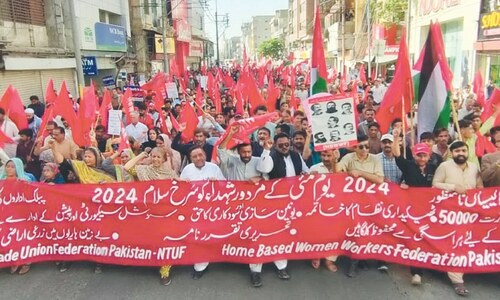
KARACHI: Motorcyclists and pillion riders remained the largest group involved in road crashes that claimed the lives of more than 1,000 people in the city last year, said an expert while sharing statistics on road accidents in 2015 during a discussion on Wednesday.
He also pointed out that 52 per cent of people who were either injured or died in the 31,041 traffic accidents reported in 2015 were brought to health facilities in private vehicles, indicating a larger scope for more efficient ambulance services.
The event titled ‘A research study on road accidents in Karachi — causes and impacts’ was organised by the Urban Resource Centre (URC) on its premises.
Giving a presentation on the subject based on Road Traffic Injury and Research and Prevention Centre (RTIRPC) data, Dr Rashid Jooma, renowned neurosurgeon and principal investigator of the study, said the statistics on traffic accidents by RTIRPC gathered from two private and three major public sector hospitals — the Jinnah Postgraduate Medical Centre (JPMC), the Abbasi Shaheed Hospital (ASH) and the Civil Hospital Karachi (CHK) — were doubled in the police data on traffic accidents.
The highest number of injuries, he said, was reported at the ASH, though the JPMC remained the top hospital in the city which catered to the most serious injuries, followed by the CHK and the ASH.
“The major reason why most injuries were reported at the ASH was the establishment of a trauma centre there that showed public willingness to utilise health facilities if they are provided,” he said.
The slides he presented to the audience showed that over 14,000 motorcyclists and 5,834 pillion-riders were injured, while 436 motorcyclists and 95 pillion-riders died in accidents last year. The other largest road user group that mostly got hit in road accidents was pedestrians, involved in 5,953 cases, where mortalities occurred in 214 cases. It was followed by passengers involved in 2,839 cases, and deaths reported in 160 cases.
Increasing road injuries among young bikers
The mortality figure, according to Dr Jooma, had shown slight variation over the years, which is very much according to global trends. However, the number of young people (largely bikers under the age of 25) injured in road crashes in Karachi was higher (52pc) than statistics from other countries.
Gadap Town reported the highest number of road crashes followed by Korangi, Keamari, Bin Qasim, Baldia, Site and Orangi. As for the thoroughfares reporting the highest number of accidents, the National Highway topped the list followed by Shahrah-i-Faisal, Korangi industrial area road, Super Highway and main Orangi road.
“Mortality and injuries to pillion-riders is showing an increasing trend and there is hardly any case in which they were found to be wearing helmets. Cases of rickshaws and Qingqis hitting motorcyclists and pedestrians have also increased,” said Dr Jooma.
He further said that one of the major factors behind the increasing number of accidents was the absence of a separation on dual-carriage ways.
The KPT flyover where some rectification measures were earlier taken to reduce road crashes was again showing deterioration and needed government attention, he observed.
Former inspector general Sindh police Asad Jahangir said the strategy to make Shahrah-i-Faisal signal free and remove intersections had encouraged road users to move on the wrong side of the road, resulting in an increasing number of accidents.
“Police patrolling is needed to discourage ‘wrong-way practice’. The road linking the Super Highway with the National Highway needs repairs as its poor condition is causing accidents. The high-ups are also required to look into the issue of illegal cuts on the Northern bypass, which are leading to accidents there,” he told the audience.
Prof Shabbar Ali of the department of urban and infrastructure engineering of the NED University of Engineering and Technology underlined the need for educating the public on road safety and said since traffic issues were purely man-made, man-made solutions could be found to address them.
Published in Dawn, May 19th, 2016














































Dear visitor, the comments section is undergoing an overhaul and will return soon.